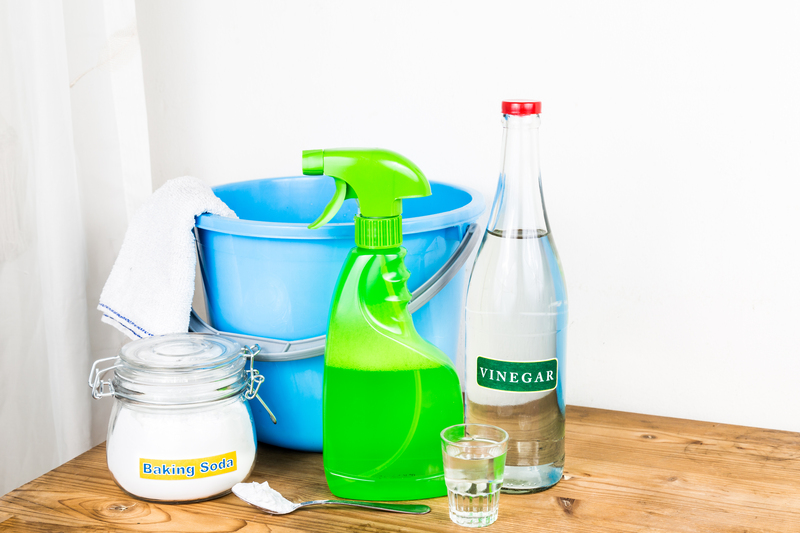Eco-Friendly Solutions for Cleaning Mouldy Window Sills
Posted on 29/08/2025
Eco-Friendly Solutions for Cleaning Mouldy Window Sills
Mould on window sills is a common household problem, especially in environments where moisture accumulates. Unfortunately, commercial cleaners often contain harsh chemicals that can harm both the environment and your health. The good news is that there are eco-friendly solutions for cleaning mouldy window sills that are effective, safe, and sustainable. This comprehensive guide will show you how to remove mould naturally, prevent its return, and keep your home healthy--all using green cleaning methods.

Understanding Why Mould Grows on Window Sills
To tackle mould effectively, it's essential to understand why it appears. Window sills are prime spots for mould growth due to:
- Condensation: Windows often have higher moisture levels, particularly during colder months.
- Poor Ventilation: Inadequate airflow allows moisture to linger, fostering an ideal environment for mould spores.
- Organic Debris: Dust, dirt, and organic materials on the sills serve as a food source for mould.
Why Choose Eco-Friendly Cleaning Methods?
Traditional mould removers frequently contain ingredients such as ammonia, bleach, and other volatile organic compounds (VOCs) that may:
- Pollute indoor air
- Release toxic fumes
- Contaminate water supplies
- Pose health risks, especially for children and pets
Preparation: Safety First
Even though you are using green cleaning agents for mould, safety remains a top priority. Take these steps before you begin:
- Wear Gloves: Protect your skin from irritants and prevent cross-contamination.
- Mask Up: Use a mask to avoid inhaling spores, especially if you have allergies.
- Ventilate: Open windows or use fans to increase airflow and reduce moisture as you clean.
- Gather Supplies: Soft brushes, old toothbrushes, microfiber cloths, spray bottles, and eco-friendly cleaning solutions.
Eco-Friendly Cleaning Solutions for Mouldy Window Sills
1. White Vinegar: The Household Powerhouse
White vinegar is renowned for its natural mould-fighting properties. Acetic acid breaks down mould structures while being safe for most window sill materials.
- How to Use: Pour undiluted vinegar into a spray bottle. Spray generously onto the affected sill. Let it sit for at least one hour for maximum effectiveness. Scrub gently using a brush or sponge. Wipe with a damp microfiber cloth.
- Bonus Tip: Avoid rinsing--the residual vinegar helps keep mould from returning.
2. Baking Soda: Gentle Yet Effective
Safe for surfaces and non-toxic, baking soda is both a cleaning agent and a mild abrasive. It also helps neutralize odours associated with mouldy window sills.
- How to Use: Mix 1-2 tablespoons of baking soda with warm water to form a paste. Apply to the mouldy area and scrub lightly with a brush. Rinse with a clean damp cloth.
- Enhance Performance: For stubborn stains, add a splash of vinegar for a fizzing boost.
3. Hydrogen Peroxide: Eco-Safe Disinfectant
Hydrogen peroxide (3%) is a versatile, biodegradable disinfectant that decomposes into water and oxygen.
- How to Use: Spray directly on the mould, let sit for 10-15 minutes, scrub, and wipe clean.
- Caution: Test first on dark or coloured window sills, as peroxide may bleach surfaces.
4. Lemon Juice: Nature's Acidic Cleaner
Lemon juice records natural antibacterial and antifungal properties.
- How to Use: Squeeze fresh lemon onto the mouldy area. Let it sit for 10-15 minutes, scrub gently, and wipe clean. It will also impart a fresh citrus scent!
5. Eco-Friendly Commercial Cleaners
There are now many plant-based, environmentally safe mould removers that avoid harsh chemicals and utilize botanical extracts. Look for products that are:
- Biodegradable
- Non-toxic
- Certified by environmental organizations (e.g., EcoLogo, Green Seal, etc.)
Step-by-Step Guide: Cleaning Mould From Window Sills Naturally
- Remove any decor or window treatments to access all affected areas.
- Dust and vacuum: Loosen and vacuum up all loose mould spores with a HEPA vacuum or microfiber cloth.
- Apply your chosen eco-friendly cleaner. Remember: generous application allows the solution to soak in and destroy mould at the root.
- Scrub carefully. Use a soft brush, toothbrush, or sponge for corners and crevices.
- Wipe and dry. Use a damp clean cloth to remove residue and then dry thoroughly using a towel or let air dry with open windows.
- Inspect and repeat as needed. For stubborn areas, you may need to repeat the process or try a different eco-friendly agent for best results.
Preventing Mould From Returning on Window Sills
Once you've tackled existing mould growth on window sills, intelligent prevention keeps it at bay. Here are some proven, sustainable practices:
- Control moisture: Use a dehumidifier or open windows regularly to reduce condensation.
- Clean sills routinely: Wipe down window sills and frames at least once a week with a vinegar solution to discourage spore settlement.
- Inspect seals and caulking: Repair cracks and leaks promptly to prevent water ingress.
- Promote airflow: Use fans or keep windows slightly ajar to ensure adequate ventilation in high-moisture areas, like bathrooms and kitchens.
- Install double-glazing: Well-insulated windows minimize condensation-related mould issues.
- Houseplants for air purification: Choose plants known for improving indoor air, like peace lily, spider plant, or English ivy, but avoid over-watering them near window sills.
Eco-Friendly Maintenance & Regular Cleaning Schedule
Maintenance is crucial for keeping window sills mould-free naturally. Establish a sustainable routine:
- Weekly: Dust and quickly wipe down window sills with a vinegar and water blend (1:3 ratio).
- Monthly: Check all window sills for hidden mould growth. Act swiftly using the natural cleaners described above if you spot any.
- Seasonally: Deep-clean all window frames, treat with a preventive solution, and inspect external window seals for leaks.
Are All Window Sill Materials Safe for Natural Mould Cleaners?
Most eco-friendly mould removal methods are gentle on standard window sill materials, including:
- Wood (painted or natural)
- uPVC and vinyl
- Metal (aluminum or steel)
However, you should spot-test any cleaner on a hidden section before full application, especially with hydrogen peroxide, because it can bleach paint or dark finishes. For natural wood, avoid oversaturating with liquid to prevent warping--apply solutions with a cloth rather than pouring or spraying directly.
Eco-Friendly Tips for Stubborn or Recurring Mould
Sometimes, particularly resilient or recurrent mould infestations require a bit more effort:
- Combine methods: Alternate or combine vinegar, baking soda, and hydrogen peroxide for a more powerful approach.
- Let the solution sit longer: For thick colonies, let your eco-friendly solution act for several hours before scrubbing.
- Repair the root cause: Persistent mould could signal leaks, structural issues, or chronic condensation, all of which need addressing.
- Change habits: Open blinds or curtains regularly to allow sunlight, which naturally inhibits mould growth.
Debunking Myths: What Not to Use on Mouldy Window Sills
- Bleach: While it kills surface mould, bleach is toxic and doesn't work as well on porous materials (like wood) as many believe. It can also harm indoor air quality and aquatic ecosystems when rinsed away.
- Harsh commercial disinfectants: Many mainstream "mould removers" have negative environmental and health effects.
- Unproven home remedies: Essential oils or alcohols can have some efficacy, but are best used in combination with above techniques for lasting results and should be used sparingly due to their potency and ecological impact.

Sustainable Disposal of Cleaning Materials
Mould-infested sponges, rags, or paper towels can spread spores if simply tossed in the bin. Here's the eco-friendly way:
- Bag and seal: Contain all waste securely, especially if your local area does not process organic waste using high-temperature composting.
- Use washable cloths: Prefer reusable microfiber cloths that can be sanitized in hot water and vinegar solutions, saving waste.
- Dispose of waste water responsibly: Pour down indoor drains, not into the garden or storm drains, to avoid environmental contamination.
Summary: Embrace Green Mould Removal Methods
Adopting eco-friendly solutions for cleaning mouldy window sills ensures a healthier home for you and your loved ones, while also minimizing your ecological footprint. By utilizing household staples like vinegar, baking soda, hydrogen peroxide, and lemon juice, you can powerfully clean and protect your windows without sacrificing sustainability.
Remember: Prevention and regular maintenance are as crucial as removal. So, open those windows, keep the sills dry, and integrate green mould cleaning practices into your cleaning schedule for sparkling, healthy, mould-free window sills all year round!
Start today--nature (and your windows) will thank you!




